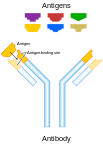Immunity in prokaryotes and eukaryotes
How does all this work? The answer is a little different, depending on whether you're talking about prokaryotes (bacteria) or eukaryotes (everybody else).
Prokaryotes:
Recall that prokaryotes don't have a nucleus in their cells, which means their genetic material is just floating around. In addition, they have plasmids -- small rings of genetic material separate from the longer chromosomes. In fact these plasmids are largely made up of resistance genes. Any given bacterial cell may have 10 or 20 resistance genes in a plasmid. Let's say a cell encounters an antibiotic like penicillin: if the cell has the appropriate resistance gene, it survives -- if not, it dies. But bacterial cells are a dime a million -- and each of those million have a different set of resistance genes. With so many cells around, at least a few are bound to have just the right gene. Those few survive and reproduce like crazy. Moreover, bacteria can do something that we eukaryotes can't -- they can exchange genetic material, specifically plasmids, just by touching each other. The plasmid is small enough to pass right through the cell membrane. So the cells with the right resistance gene quickly pass it to other cells as well, even cells of different species, and resistance evolves even faster.
Eukaryotes:
Eukaryotes are a lot more careful with their genetic material. They keep DNA locked up in a nucleus, and they don't allow little bits of it to float around as plasmids. This control allows eukaryotes to achieve more complexity, but it also presents a problem for responding to rapid changes in diseases.

So, eukaryotes do something a little different. They fight off diseases with antibodies -- molecules that can "recognize" the shape of the disease cell. Antibodies are a bit like enzymes, in that they are complex 3-D molecules. However, enzymes are made by a single gene (1 gene = 1 enzyme = 1 job), while antibodies are cobbled together by several fragments of genes. Human cells contain less than a hundred of these gene fragments, but by combining them in different ways, they can create millions of different antibodies. These different antibodies get stuck on the tips of the "hypervariable" regions of the Y-shaped antibodies. In addition, the gene fragments themselves undergo "hypermutation" -- very high levels of mutation, so that even more new antibodies are created.
The take-home message here is that both prokaryotes and eukaryotes have ways to radically increase the variability contained in their immune systems. Remember that variability is the "raw material" of evolution. The existing high levels of variability in immune function allow species to get off to a quick start in evolving resistance to a variety of diseases, pesticides, and antibiotics.
If you want a printer-friendly version of this module, you can find it here in a Microsoft Word document. This printer-friendly version should be used only to review, as it does not contain any of the interactive material, and only a skeletal version of problems solved in the module.
Copyright University of Maryland, 2007
You may link to this site for educational purposes.
Please do not copy without permission
requests/questions/feedback email: mathbench@umd.edu